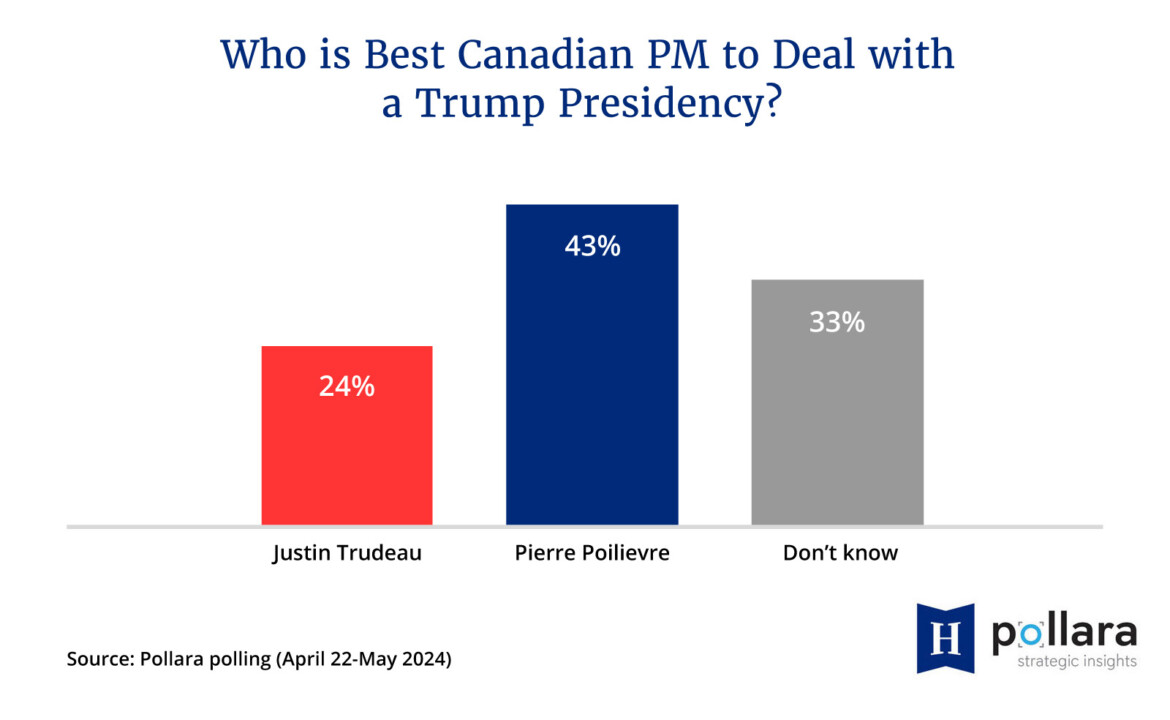
In the lead-up to the November 2024 U.S. presidential election, The Hub and Pollara are teaming up to provide insights into what Canadians make of the race as it unfolds. Pollara senior advisor Andre Turcotte will provide exclusive polling and analysis to Hub readers, helping them understand how fellow Canadians are making sense of the election and its implications for Canada.
Conventional wisdom dictates that as he’s preparing for the Canadian election, Conservative leader Pierre Poilevre is probably praying that Donald Trump loses the American presidential election, now only six months away. The Liberals are betting on it, having launched a new ad campaign that directly compares the leader of the Official Opposition to the reality TV star-turned U.S. president, who is now appearing in court. Justin Trudeau and team are certainly hoping to stoke fear around the idea of putting two uncooperative outspoken conservative populists in power, while feeding the idea that Poilievre is just as brash, untruthful, and controversial as Trump.
However, new data collected by Pollara and published exclusively by The Hub surprisingly shows that 43 percent of Canadians actually believe a Prime Minister Poilievre would be best suited to deal with another Trump presidency.

Meanwhile, 24 percent of Canadians believe Prime Minister Trudeau would be best at dealing with Trump, having done so in the past during the renegotiation of NAFTA and various other trade battles.
According to our polling, Poilievre emerges as the best to handle Trump for a plurality of Canadians of all ages (except older Canadians) and across every region. Not unexpectedly, we find partisan divisions on this point. A solid majority of Conservative voters (88 percent) prefer their own leader while 75 percent of Liberal supporters have more confidence in Justin Trudeau. What is interesting and an opportunity for Poilievre is that a significant proportion of Green (27 percent), Bloc (23 percent), and NDP (18 percent) voters as well as eight percent of Liberal supporters would turn to Poilievre to handle a second Trump presidency.

The closest of friends
“The longest open border in the world”; “steadfast allies”; the “closest of friends and allies”; those are just a few ways politicians have described the nature of the relationship between Canada and the United States over the years. Confrontations between Canadian and U.S. leaders have been relatively rare throughout history, owing to the generally strong diplomatic and economic ties between the two countries. However, there have been many instances when our leaders have clashed publicly or in private.
There was the infamous incident in April 1965 involving Lester B. Pearson, who was then Canada’s external affairs minister, and Lyndon B. Johnson, who was president at the time. In a speech delivered in Philadelphia, Lester B. Pearson criticized the U.S. bombing campaign in Vietnam and advocated for a halt to the carnage. President Johnson felt personally attacked by Pearson’s remarks. When the two men met later, Johnson grabbed Pearson by the lapels and shouted at him, “Don’t you come into my living room and piss on my rug!”
Pierre-Elliott Trudeau had a strained relationship with Richard Nixon. The two clashed over several issues including trade and Canada’s opposition to the Vietnam War. The animosity was in full display when Nixon was recorded calling the former prime minister a “pompous egghead”.
More recently, Jean Chrétien’s decision not to participate in the U.S.-led invasion of Iraq in 2003 seriously damaged relations with President George W. Bush.
With the U.S. presidential election approaching and the outcome still uncertain, we decided to examine Canadians’ expectations regarding which of the two main federal party leaders would be best equipped to handle relations with the next U.S. president. Our most recent study, conducted between April 22nd and May 2nd with 1,500 adult Canadians, aimed to explore this topic.
President Biden remains the preferred choice of most Canadians. Specifically, 58 percent want to see Biden win in November, but his support has slipped three points since March. Only 21 percent of Canadians prefer Donald Trump.
But, despite their preferences, Canadians are divided in terms of who they expect to win. Some 28 percent think Trump will be the likely winner (down 3 percent from March) while 26 percent expect Biden to win (down 1 percent since March).

What would a Biden presidency mean for Canada?
Canadians are largely detached about a potential second term for Joe Biden. When asked what a Biden re-election would mean for Canada, 25 percent say it would be a good thing and 19 percent say it would be bad. About one-third (34 percent) are neutral.
There is very little variation across socio-economic groups. However, Canadians over the age of 64 (52 percent) and Quebecers (46 percent) are slightly more likely than others to view a second Biden mandate in positive terms. However, there are partisan differences. Bloc (63 percent), Liberal (62 percent), and NDP (49 percent) supporters are sympathetic to a Biden re-election, while 31 percent of Conservatives believe a second Biden administration would be a “bad thing for Canada,” compared to 21 percent who think it would be good, and another 37 percent who are neutral.
Detachment is also found with regards to which of the two main federal party leaders would be best at dealing with President Biden. Some 35 percent of Canadians think Poilievre would be best equipped to deal with President Biden. An almost identical proportion (33 percent) think Trudeau would be best, and 32 percent are unsure.

However, while Canadians may be indifferent to a second Biden term, the possibility of Trump returning to the White House evokes strong opinions and significant divisions.
What would a Trump presidency mean for Canada?
A strong majority of Canadians (60 percent) think another Trump presidency would be “a bad thing for Canada.” This is largely unchanged from our previous study conducted in March. Older Canadians (83 percent), Quebecers (74 percent), women (67 percent), and British Columbians (66 percent) are most likely to see a Trump re-election in a negative light.
Partisanship also has an impact on this issue with Bloc (90 percent), Liberals (84 percent), and NDP (81 percent) voters united in dreading a Trump return to the White House. In contrast, Conservative voters are more ambivalent about this possible outcome. Specifically, 43 percent of Conservatives think a Trump return would be bad for our country while 25 percent think it would be a good thing, and 22 percent remain neutral.
What does this mean for Poilievre?
On January 20, 2025, a new U.S. President will be inaugurated. Later that year, Canadian voters will head to the polls. Although it’s too early to predict how Canada-U.S. relations will influence the upcoming federal election, if they do, it could strain Liberal support and benefit the Poilievre Conservatives. For Poilievre to capitalize on this, he needs to adjust his approach. While aligning with the MAGA populist appeal might be tempting, continuing down this path could be detrimental. If Trump wins in November, Canadians will likely seek a tough leader who can stand up to the new administration. Poilievre should take a cue from previous Liberal prime ministers—Pearson, Trudeau, and Chretien—who demonstrated that confronting a belligerent U.S. president can yield electoral benefits.
Recommended for You

Laura David: Red pill, blue pill: Google has made its opening salvo in the AI-news war. What’s Canadian media’s next move?

The Notebook by Theo Argitis: Mark Carney’s first major tests

The Weekly Wrap: Trudeau left Canada in terrible fiscal shape—and now Carney’s on clean-up duty

Ben Woodfinden: Lament for an ‘elbows up’ nation



